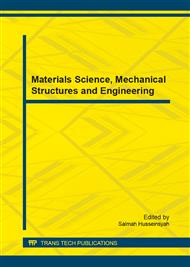[1]
Maczulak, A. (2010). 3. Environmental Toxins. Pollution: Treating Environmental Toxins, pp.54-88. New York: Facts On File, Inc.
Google Scholar
[2]
Ahalya, N., Ramachandra, T. V. &Kanamadi, R. D. (2003). Biosorption of Heavy Metals. Research Journal of Chemistry and Environment, Vol. 7, pp.71-79.
Google Scholar
[3]
Liu, C., Ngo, H. H. &Guo, W. S. (2012). Watermelon Rind: Agro-waste or Superior Biosorbent. Appl. Biochem. Biotechnol., Vol. 167, pp.1699-1715.
DOI: 10.1007/s12010-011-9521-7
Google Scholar
[4]
Wang, J. & Chen, C. (2010). Research Advances in Heavy Metal Removal by Biosorption. Acta Sci. Circumstantiae, Vol. 30, pp.673-701.
Google Scholar
[5]
Fu, F. & Wang, Q. (2011). Removal of Heavy Metal Ions from Wastewaters: A Review. Journal of Environment Management, Vol. 92, pp.407-418.
DOI: 10.1016/j.jenvman.2010.11.011
Google Scholar
[6]
Igwe, J. C., Ogunewe, D. N. &Abia, A. A. (2005). Competitive Adsorption of Zn(II), Cd(II), and Pb(II) Ions from Aqueous and Non-aqueous Solution by Maize Cob and Husk. Afr. J. Biotechnol., Vol. 4(10), pp.1113-1116.
DOI: 10.1590/s0100-46702007000100005
Google Scholar
[7]
Das, N., Vimala, R. &Karthika, P. (2008b). Biosorption of Heavy Metals – An Overview. Indian Journal of Biotechnology, Vol. 7, pp.159-169.
Google Scholar
[8]
Nguyen, T. A. H., Ngo, H. H., Guo, W. S., Zhang, J., Liang, S., Yue, Q. Y., Li, Q. & Nguyen, T. V. (2013).
Google Scholar
[9]
Agnes, M. R. & Penelope, M. P. V. (2005). Determination of Citrulline in Watermelon Rind. J. Chromatogr. A 1078, pp.196-200.
Google Scholar
[10]
Andrew, M., Zheng, Y., Qju, F., Nimtzc, M. & Bell-Eunice, G. (2008).
Google Scholar
[11]
Kumar, J., Balomajumder, C. &Mondal, C. (2011). Application of Agro-Based Biomasses for Zinc Removal from Wastewater – A Review. Clean – Soil Air Water, Vol. 39, pp.641-652.
DOI: 10.1002/clen.201000100
Google Scholar
[12]
Lakshmipathy, R. &Sarada, N. C. (2013). Application of Watermelon Rind as Sorbent for Removal of Nickel and Cobalt from Aqueous Solution. International Journal of Mineral Processing, Vol. 122, pp.63-65.
DOI: 10.1016/j.minpro.2013.03.002
Google Scholar
[13]
Osman, H. E., Badwy, R. K. & Ahmad, H. F. (2010). Usage of Some Agricultural By-products in the Removal of Some Heavy Metals from Industrial Wastewater. J. Phytol, Vol. 2, pp.51-62.
Google Scholar
[14]
Marin, A. B. P., Aguilar, M. I., Ortuna, J. F., Meseguer, V. F., Saez, J. &Florenz, M. (2010). Biosorpton of Zn(II) by Orange Waste in Batch and Packed Bed Syatems. J. Chem. Technol. Biotechnol, Vol. 85, pp.1310-1318.
DOI: 10.1002/jctb.2432
Google Scholar


